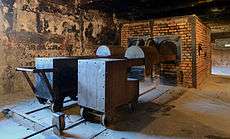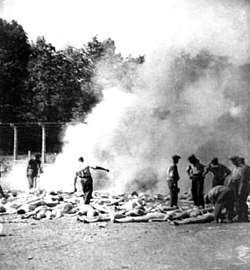Filip Müller
.jpg)
Filip Müller (3 January 1922 – 9 November 2013) was a Slovak Jewish Holocaust survivor who was one of Sonderkommando members at Auschwitz, the largest Nazi German extermination camp of World War II. He witnessed the extermination of Jews and published a memoir, Eyewitness Auschwitz - Three Years in the Gas Chambers, in 1979.[1]
Life

Müller was born in Sereď, in the Czechoslovak Republic. In April 1942, at the age of twenty, he was in one of the earliest Holocaust transports to Auschwitz. He was given prisoner number 29236 and assigned to work on the construction of crematoria and the installation of the gas chambers. As member of the Sonderkommando, he witnessed "the families, the townships and the cities of Jewish people come". He was ordered to burn the dead bodies in ovens. His ability in the job of cremating corpses was the only reason the Germans kept him alive.[2]
The daily arrivals of men, women and children at Auschwitz were met by Müller's Sonderkommando unit in the so-called cleaning area. Müller would tell the prisoners that they were somewhere safe as he worked around them getting the gas chambers ready.
After the Jews had been killed in the gas chambers, his role was to enter the gas chambers with other workers, and to search and sort the bodies by size and fat content, in order to maximize how many bodies could be burned per hour. Then he and the other unit members would move and load the bodies into the crematorium chamber and "stoke" the bodies as they burned so they burned efficiently. Their clothes were also collected and disinfected, and any valuables found in them were either taken by SS officials or used by prisoners who had "organized" (stolen) them to barter with the SS officials for food or other supplies. Müller described eating cheese and cake he found once in the gas chamber after a gassing.[3]
Eye witness
After realizing what he was doing to the thousands of Jews every day for nearly three years, Müller said that he tried to commit suicide by attempting to enter the gas chamber himself. In his book, he said he saw a group of countrymen singing the Jewish Hatikvah and the Czech national anthem before they entered the gas chamber. He joined the group inside but after a few minutes a girl came up and spoke to him. According to Muller, she said:
We understand that you have chosen to die with us of your own free will, and we have come to tell you that we think your decision is pointless: for it helps no one... We must die, but you still have a chance to save your life. You have to return to the camp and tell everybody about our last hours. You have to explain to them that they must free themselves from any illusions. They ought to fight, that's better than dying here helplessly. It'll be easier for them, since they have no children. As for you, perhaps you'll survive this terrible tragedy and then you must tell everybody what happened to you. — Müller, 1979, p. 113

Müller came to believe that he had to stay alive so that he and other survivors could tell the story behind the Holocaust. Müller worked as a prisoner in the Sonderkommando until January 1945, when he was evacuated from Auschwitz, and he was freed in May 1945 in Gunskirchen, a sub-camp of the Mauthausen concentration camp. According to Raul Hilberg in The Destruction of the European Jews, gassing operations ceased in Auschwitz in November 1944, by order of Heinrich Himmler.
After the war
Müller first testified during his recovery in a post-liberation hospital. His statement was originally published in an obscure Czech collection, but it was reprinted in the 1966 book The Death Factory, written by two other Holocaust survivors, Erich Kulka and Ota Kraus. Müller testified at the Second Frankfurt Auschwitz Trials in 1964. During the trial he stated that in summer of 1942 he was transferred from the Sonderkommando of crematorium 1 to Monowitz thus spending only about six weeks in crematorium 1, not about 14 months as he would claim later in his book. The Monowitz subcamp, seven kilometres from the main Auschwitz site, was a labor camp run by the German firm IG Farben, and there were no crematoria there. [4] For the remainder of his imprisonment at Auschwitz, Müller worked mainly at Birkenau, where the main crematoria were located. He was interviewed in Claude Lanzmann's Shoah documentary.[5]
After 1969, Müller lived in the West. He died on November 9, 2013, at the age of 91.
Published works
Müller, Filip (1 January 1999) [1979]. Flatauer, Susanne, ed. Eyewitness Auschwitz: Three Years in the Gas Chambers. Translated by Flatauer, Susanne. Helmut Freitag. Chicago: Ivan R. Dee. ISBN 978-1-56663-271-3. OCLC 906829134. Retrieved 11 January 2016.
See also
References
- ↑ A-P (2015). "Filip Müller". Der Auschwitz-Prozess, Frankfurt. Retrieved 18 September 2015.
- ↑ Müller, Filip (1999) [1979]. Eyewitness Auschwitz - Three Years in the Gas Chambers. Ivan R. Dee in association with the United States Holocaust Memorial Museum. p. 180–. ISBN 1-56663-271-4.
- ↑ Filip Müller. Eyewitness Auschwitz: Three Years in the Gas Chambers (1999 edition), page 13.
- ↑ Zeuge Filip Müller:
In dem Auschwitzer Krematorium war ich so bis gegen Ende Juni oder Anfang August, das kann ich nicht, das kann ich nicht
Vorsitzender Richter [unterbricht]: Nun, wieviel Wochen waren es denn ungefähr?
Zeuge Filip Müller: Sechs Wochen.
Vorsitzender Richter: Sechs Wochen.
Zeuge Filip Müller: Ungefähr sechs Wochen.
Digitale Bibliothek 101: Der Auschwitz-Prozess, 1. Aufl. (Das Verfahren: 97. Verhandlungstag (05.10.1964). Der 1. Frankfurter Auschwitz-Prozeß, S. 20506 (vgl. AP179.007, S. 0)) - ↑ Hata, George (8 December 1985), In a brilliant documentary on the Holocaust, survivors' memories purge the ultimate evil, Reading Eagle
General references
- Account - Filip Müller, survivor of Auschwitz at Auschwitz.dk webpage.
- Auschwitz Survivor Filip Muller's Testimony at Remember.org.
- Filip Müller page at sonderkommando.info. [In French.]